Managing People and Systems: Motivation Theories Report Analysis
VerifiedAdded on 2023/06/07
|8
|2151
|500
Report
AI Summary
This report delves into various motivation theories and their practical applications within the modern workplace. It begins by exploring Maslow's hierarchy of needs, detailing how organizations can cater to employees' physiological, safety, belonging, esteem, and self-actualization needs to enhance motivation. The report then examines Herzberg's two-factor theory, distinguishing between hygiene factors and motivators, and how management can leverage these factors to increase job satisfaction and reduce dissatisfaction. Finally, it analyzes McGregor's X and Y theory, contrasting the assumptions about employee behavior and suggesting how different management approaches can be used to motivate employees effectively. The report concludes by emphasizing the significance of motivation in improving employee performance and achieving organizational goals, drawing from the presented theories to provide a comprehensive understanding of motivational strategies.
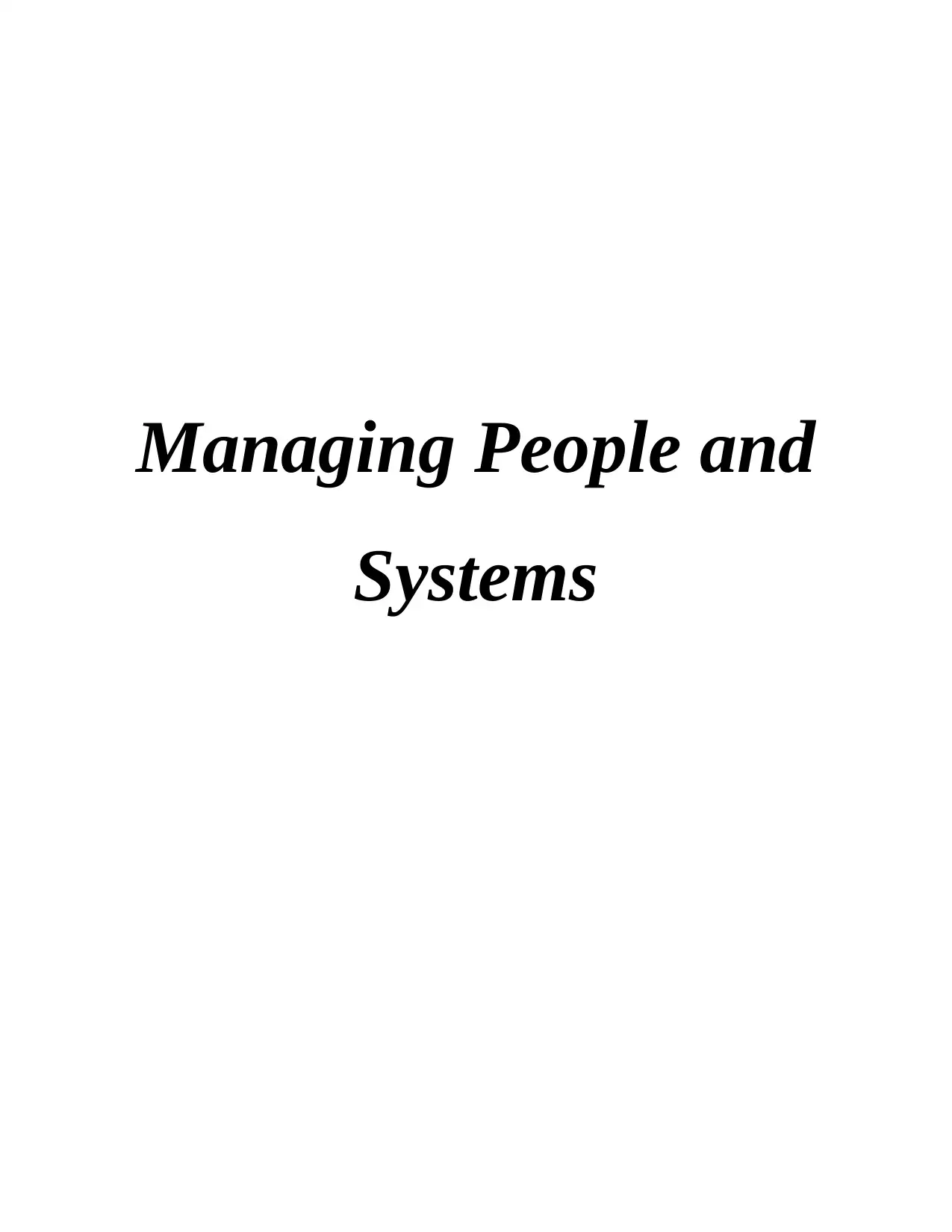
Managing People and
Systems
Systems
Paraphrase This Document
Need a fresh take? Get an instant paraphrase of this document with our AI Paraphraser
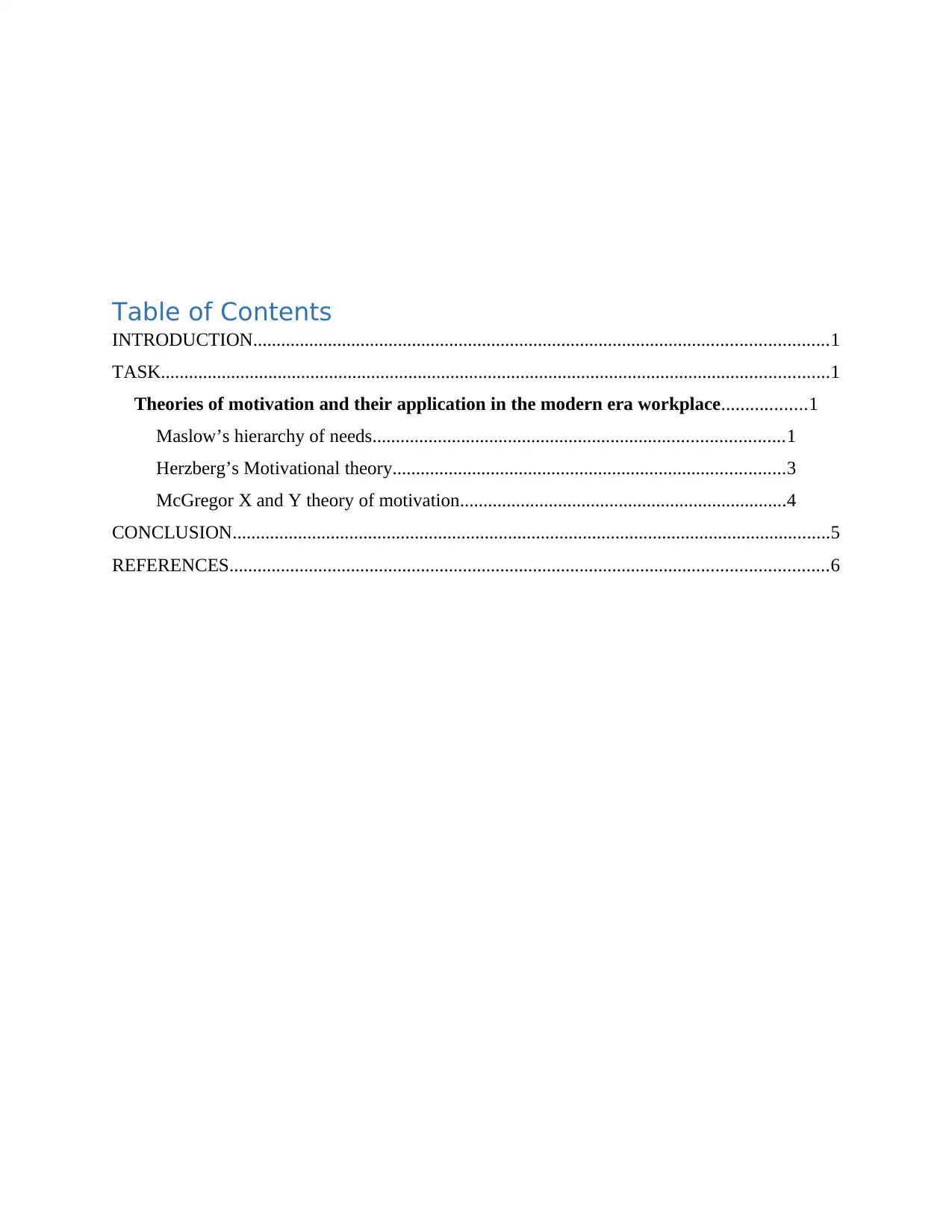
Table of Contents
INTRODUCTION...........................................................................................................................1
TASK...............................................................................................................................................1
Theories of motivation and their application in the modern era workplace..................1
Maslow’s hierarchy of needs........................................................................................1
Herzberg’s Motivational theory....................................................................................3
McGregor X and Y theory of motivation......................................................................4
CONCLUSION................................................................................................................................5
REFERENCES................................................................................................................................6
INTRODUCTION...........................................................................................................................1
TASK...............................................................................................................................................1
Theories of motivation and their application in the modern era workplace..................1
Maslow’s hierarchy of needs........................................................................................1
Herzberg’s Motivational theory....................................................................................3
McGregor X and Y theory of motivation......................................................................4
CONCLUSION................................................................................................................................5
REFERENCES................................................................................................................................6
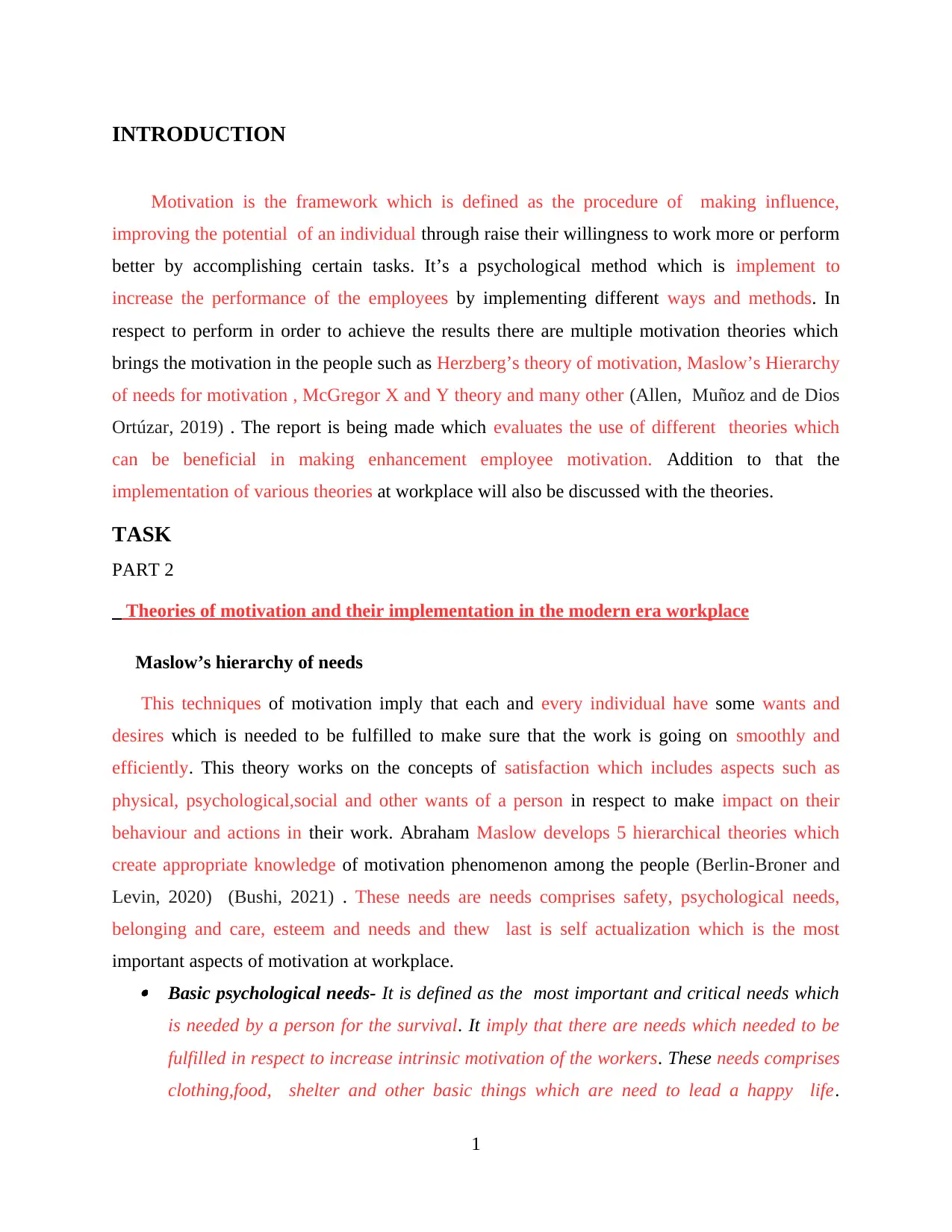
INTRODUCTION
Motivation is the framework which is defined as the procedure of making influence,
improving the potential of an individual through raise their willingness to work more or perform
better by accomplishing certain tasks. It’s a psychological method which is implement to
increase the performance of the employees by implementing different ways and methods. In
respect to perform in order to achieve the results there are multiple motivation theories which
brings the motivation in the people such as Herzberg’s theory of motivation, Maslow’s Hierarchy
of needs for motivation , McGregor X and Y theory and many other (Allen, Muñoz and de Dios
Ortúzar, 2019) . The report is being made which evaluates the use of different theories which
can be beneficial in making enhancement employee motivation. Addition to that the
implementation of various theories at workplace will also be discussed with the theories.
TASK
PART 2
Theories of motivation and their implementation in the modern era workplace
Maslow’s hierarchy of needs
This techniques of motivation imply that each and every individual have some wants and
desires which is needed to be fulfilled to make sure that the work is going on smoothly and
efficiently. This theory works on the concepts of satisfaction which includes aspects such as
physical, psychological,social and other wants of a person in respect to make impact on their
behaviour and actions in their work. Abraham Maslow develops 5 hierarchical theories which
create appropriate knowledge of motivation phenomenon among the people (Berlin-Broner and
Levin, 2020) (Bushi, 2021) . These needs are needs comprises safety, psychological needs,
belonging and care, esteem and needs and thew last is self actualization which is the most
important aspects of motivation at workplace. Basic psychological needs- It is defined as the most important and critical needs which
is needed by a person for the survival. It imply that there are needs which needed to be
fulfilled in respect to increase intrinsic motivation of the workers. These needs comprises
clothing,food, shelter and other basic things which are need to lead a happy life.
1
Motivation is the framework which is defined as the procedure of making influence,
improving the potential of an individual through raise their willingness to work more or perform
better by accomplishing certain tasks. It’s a psychological method which is implement to
increase the performance of the employees by implementing different ways and methods. In
respect to perform in order to achieve the results there are multiple motivation theories which
brings the motivation in the people such as Herzberg’s theory of motivation, Maslow’s Hierarchy
of needs for motivation , McGregor X and Y theory and many other (Allen, Muñoz and de Dios
Ortúzar, 2019) . The report is being made which evaluates the use of different theories which
can be beneficial in making enhancement employee motivation. Addition to that the
implementation of various theories at workplace will also be discussed with the theories.
TASK
PART 2
Theories of motivation and their implementation in the modern era workplace
Maslow’s hierarchy of needs
This techniques of motivation imply that each and every individual have some wants and
desires which is needed to be fulfilled to make sure that the work is going on smoothly and
efficiently. This theory works on the concepts of satisfaction which includes aspects such as
physical, psychological,social and other wants of a person in respect to make impact on their
behaviour and actions in their work. Abraham Maslow develops 5 hierarchical theories which
create appropriate knowledge of motivation phenomenon among the people (Berlin-Broner and
Levin, 2020) (Bushi, 2021) . These needs are needs comprises safety, psychological needs,
belonging and care, esteem and needs and thew last is self actualization which is the most
important aspects of motivation at workplace. Basic psychological needs- It is defined as the most important and critical needs which
is needed by a person for the survival. It imply that there are needs which needed to be
fulfilled in respect to increase intrinsic motivation of the workers. These needs comprises
clothing,food, shelter and other basic things which are need to lead a happy life.
1
⊘ This is a preview!⊘
Do you want full access?
Subscribe today to unlock all pages.

Trusted by 1+ million students worldwide
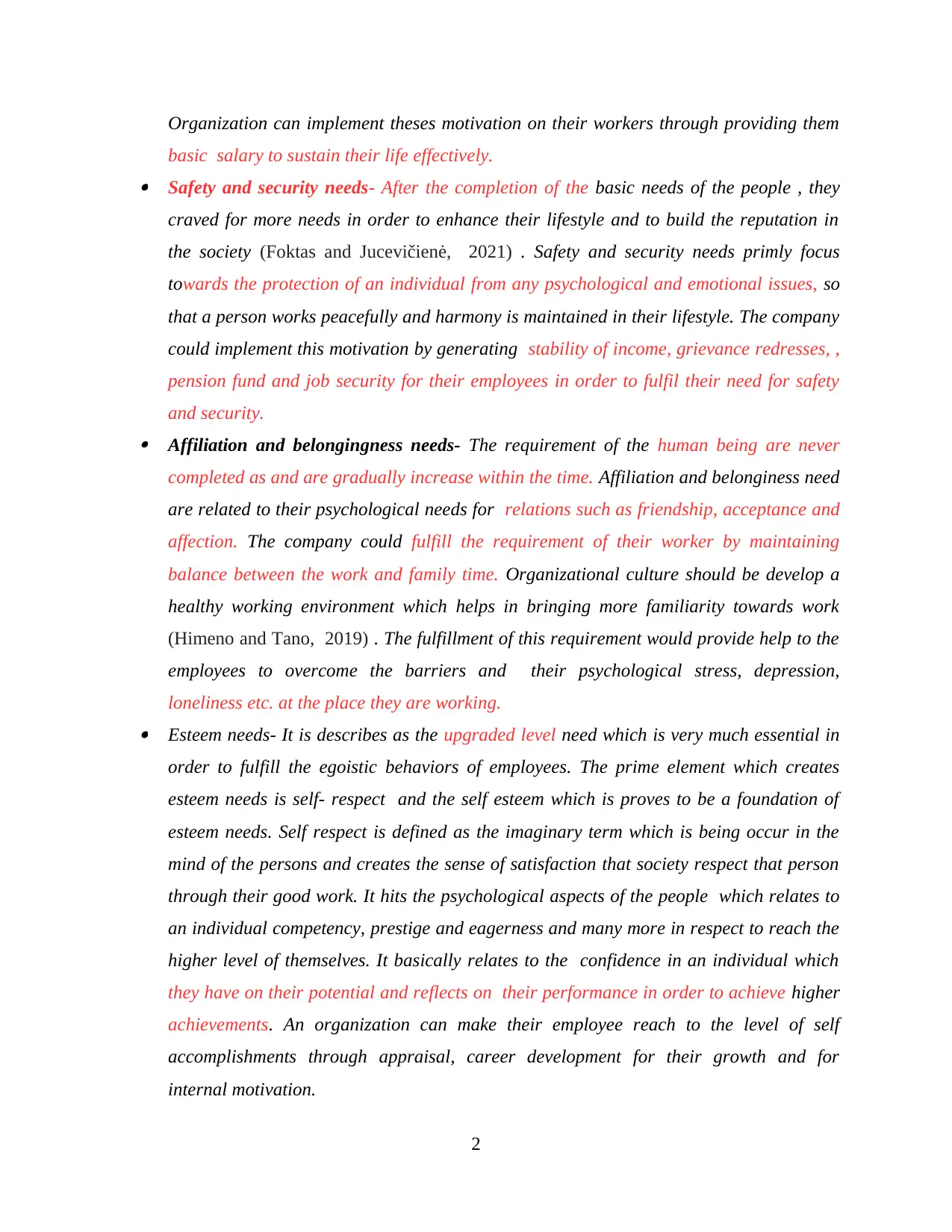
Organization can implement theses motivation on their workers through providing them
basic salary to sustain their life effectively. Safety and security needs- After the completion of the basic needs of the people , they
craved for more needs in order to enhance their lifestyle and to build the reputation in
the society (Foktas and Jucevičienė, 2021) . Safety and security needs primly focus
towards the protection of an individual from any psychological and emotional issues, so
that a person works peacefully and harmony is maintained in their lifestyle. The company
could implement this motivation by generating stability of income, grievance redresses, ,
pension fund and job security for their employees in order to fulfil their need for safety
and security. Affiliation and belongingness needs- The requirement of the human being are never
completed as and are gradually increase within the time. Affiliation and belonginess need
are related to their psychological needs for relations such as friendship, acceptance and
affection. The company could fulfill the requirement of their worker by maintaining
balance between the work and family time. Organizational culture should be develop a
healthy working environment which helps in bringing more familiarity towards work
(Himeno and Tano, 2019) . The fulfillment of this requirement would provide help to the
employees to overcome the barriers and their psychological stress, depression,
loneliness etc. at the place they are working. Esteem needs- It is describes as the upgraded level need which is very much essential in
order to fulfill the egoistic behaviors of employees. The prime element which creates
esteem needs is self- respect and the self esteem which is proves to be a foundation of
esteem needs. Self respect is defined as the imaginary term which is being occur in the
mind of the persons and creates the sense of satisfaction that society respect that person
through their good work. It hits the psychological aspects of the people which relates to
an individual competency, prestige and eagerness and many more in respect to reach the
higher level of themselves. It basically relates to the confidence in an individual which
they have on their potential and reflects on their performance in order to achieve higher
achievements. An organization can make their employee reach to the level of self
accomplishments through appraisal, career development for their growth and for
internal motivation.
2
basic salary to sustain their life effectively. Safety and security needs- After the completion of the basic needs of the people , they
craved for more needs in order to enhance their lifestyle and to build the reputation in
the society (Foktas and Jucevičienė, 2021) . Safety and security needs primly focus
towards the protection of an individual from any psychological and emotional issues, so
that a person works peacefully and harmony is maintained in their lifestyle. The company
could implement this motivation by generating stability of income, grievance redresses, ,
pension fund and job security for their employees in order to fulfil their need for safety
and security. Affiliation and belongingness needs- The requirement of the human being are never
completed as and are gradually increase within the time. Affiliation and belonginess need
are related to their psychological needs for relations such as friendship, acceptance and
affection. The company could fulfill the requirement of their worker by maintaining
balance between the work and family time. Organizational culture should be develop a
healthy working environment which helps in bringing more familiarity towards work
(Himeno and Tano, 2019) . The fulfillment of this requirement would provide help to the
employees to overcome the barriers and their psychological stress, depression,
loneliness etc. at the place they are working. Esteem needs- It is describes as the upgraded level need which is very much essential in
order to fulfill the egoistic behaviors of employees. The prime element which creates
esteem needs is self- respect and the self esteem which is proves to be a foundation of
esteem needs. Self respect is defined as the imaginary term which is being occur in the
mind of the persons and creates the sense of satisfaction that society respect that person
through their good work. It hits the psychological aspects of the people which relates to
an individual competency, prestige and eagerness and many more in respect to reach the
higher level of themselves. It basically relates to the confidence in an individual which
they have on their potential and reflects on their performance in order to achieve higher
achievements. An organization can make their employee reach to the level of self
accomplishments through appraisal, career development for their growth and for
internal motivation.
2
Paraphrase This Document
Need a fresh take? Get an instant paraphrase of this document with our AI Paraphraser
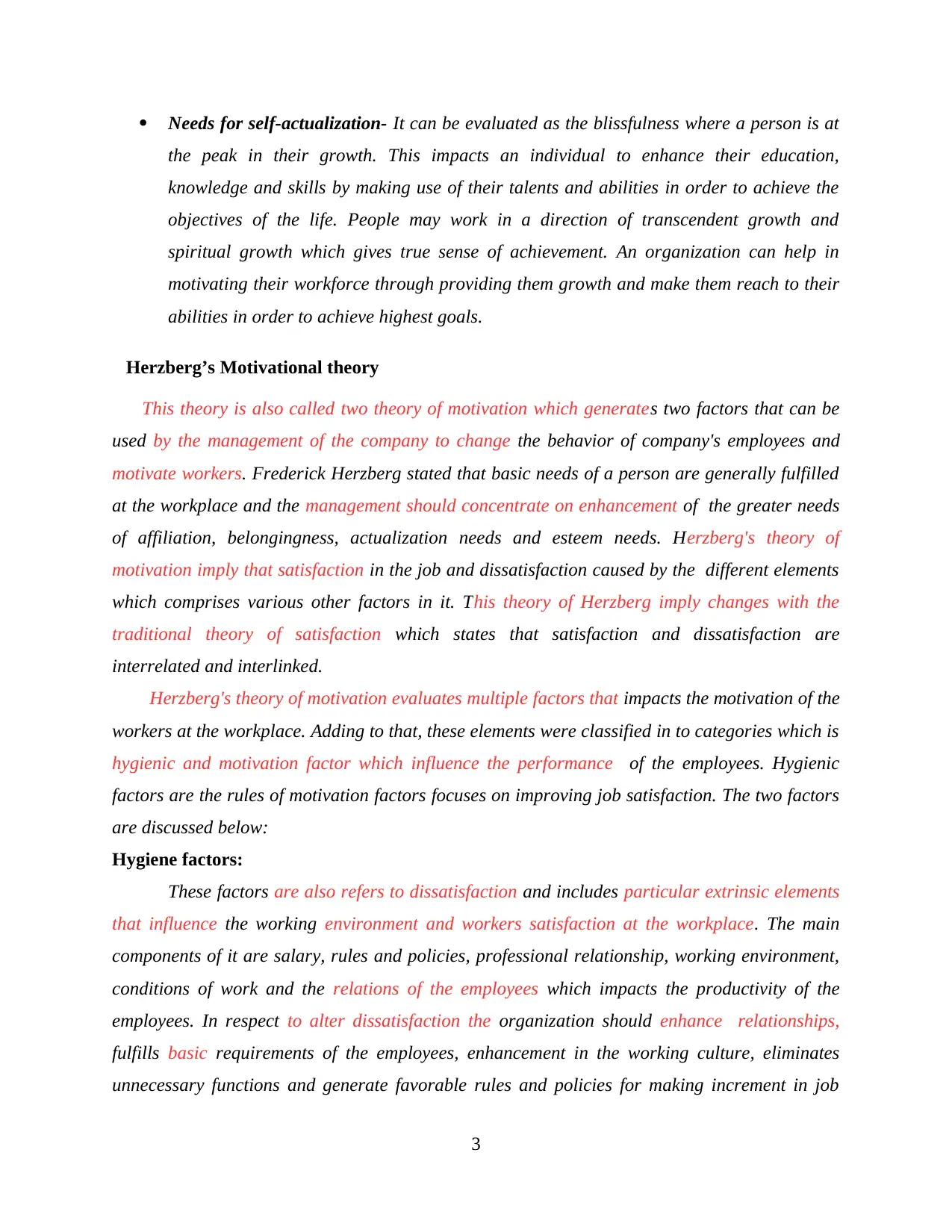
Needs for self-actualization- It can be evaluated as the blissfulness where a person is at
the peak in their growth. This impacts an individual to enhance their education,
knowledge and skills by making use of their talents and abilities in order to achieve the
objectives of the life. People may work in a direction of transcendent growth and
spiritual growth which gives true sense of achievement. An organization can help in
motivating their workforce through providing them growth and make them reach to their
abilities in order to achieve highest goals.
Herzberg’s Motivational theory
This theory is also called two theory of motivation which generates two factors that can be
used by the management of the company to change the behavior of company's employees and
motivate workers. Frederick Herzberg stated that basic needs of a person are generally fulfilled
at the workplace and the management should concentrate on enhancement of the greater needs
of affiliation, belongingness, actualization needs and esteem needs. Herzberg's theory of
motivation imply that satisfaction in the job and dissatisfaction caused by the different elements
which comprises various other factors in it. This theory of Herzberg imply changes with the
traditional theory of satisfaction which states that satisfaction and dissatisfaction are
interrelated and interlinked.
Herzberg's theory of motivation evaluates multiple factors that impacts the motivation of the
workers at the workplace. Adding to that, these elements were classified in to categories which is
hygienic and motivation factor which influence the performance of the employees. Hygienic
factors are the rules of motivation factors focuses on improving job satisfaction. The two factors
are discussed below:
Hygiene factors:
These factors are also refers to dissatisfaction and includes particular extrinsic elements
that influence the working environment and workers satisfaction at the workplace. The main
components of it are salary, rules and policies, professional relationship, working environment,
conditions of work and the relations of the employees which impacts the productivity of the
employees. In respect to alter dissatisfaction the organization should enhance relationships,
fulfills basic requirements of the employees, enhancement in the working culture, eliminates
unnecessary functions and generate favorable rules and policies for making increment in job
3
the peak in their growth. This impacts an individual to enhance their education,
knowledge and skills by making use of their talents and abilities in order to achieve the
objectives of the life. People may work in a direction of transcendent growth and
spiritual growth which gives true sense of achievement. An organization can help in
motivating their workforce through providing them growth and make them reach to their
abilities in order to achieve highest goals.
Herzberg’s Motivational theory
This theory is also called two theory of motivation which generates two factors that can be
used by the management of the company to change the behavior of company's employees and
motivate workers. Frederick Herzberg stated that basic needs of a person are generally fulfilled
at the workplace and the management should concentrate on enhancement of the greater needs
of affiliation, belongingness, actualization needs and esteem needs. Herzberg's theory of
motivation imply that satisfaction in the job and dissatisfaction caused by the different elements
which comprises various other factors in it. This theory of Herzberg imply changes with the
traditional theory of satisfaction which states that satisfaction and dissatisfaction are
interrelated and interlinked.
Herzberg's theory of motivation evaluates multiple factors that impacts the motivation of the
workers at the workplace. Adding to that, these elements were classified in to categories which is
hygienic and motivation factor which influence the performance of the employees. Hygienic
factors are the rules of motivation factors focuses on improving job satisfaction. The two factors
are discussed below:
Hygiene factors:
These factors are also refers to dissatisfaction and includes particular extrinsic elements
that influence the working environment and workers satisfaction at the workplace. The main
components of it are salary, rules and policies, professional relationship, working environment,
conditions of work and the relations of the employees which impacts the productivity of the
employees. In respect to alter dissatisfaction the organization should enhance relationships,
fulfills basic requirements of the employees, enhancement in the working culture, eliminates
unnecessary functions and generate favorable rules and policies for making increment in job
3
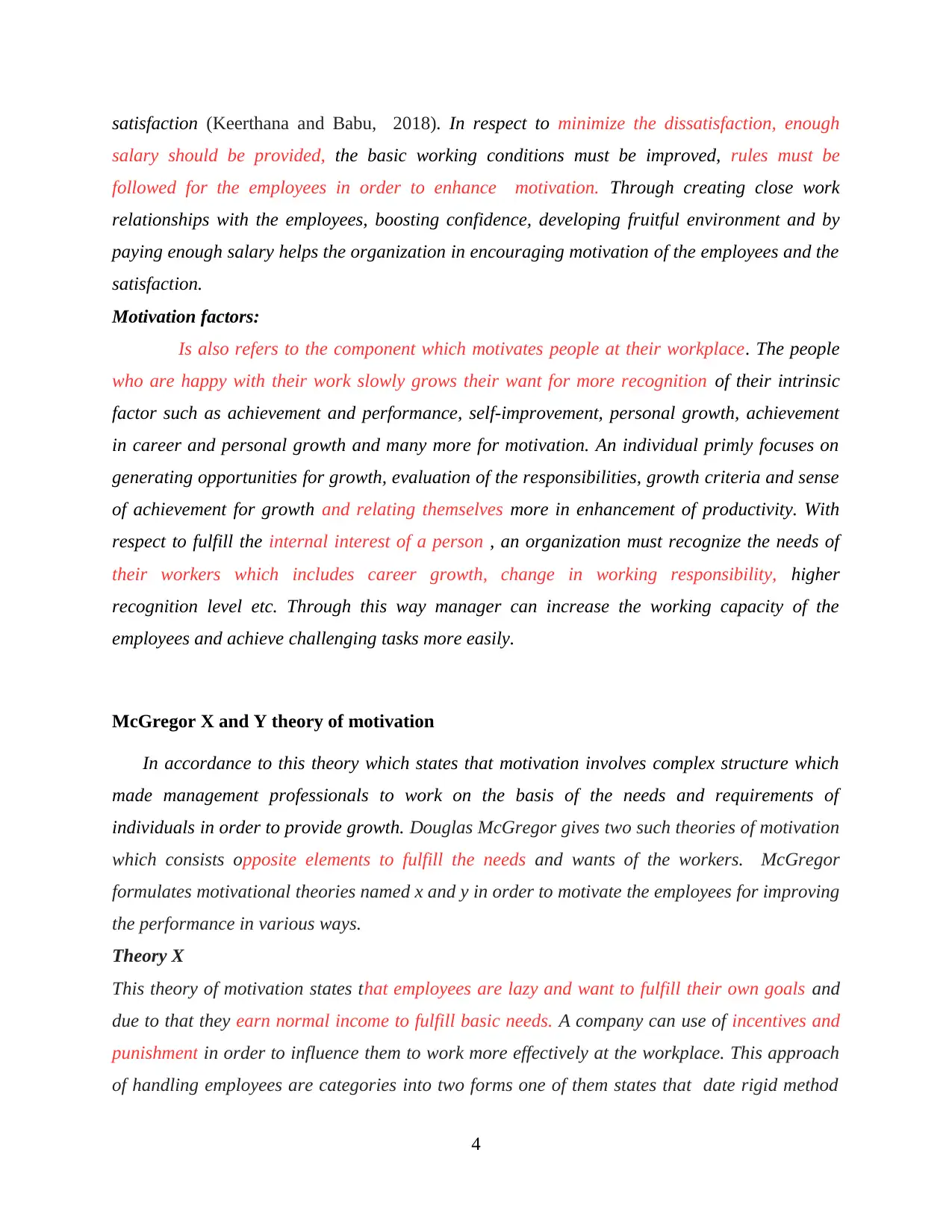
satisfaction (Keerthana and Babu, 2018). In respect to minimize the dissatisfaction, enough
salary should be provided, the basic working conditions must be improved, rules must be
followed for the employees in order to enhance motivation. Through creating close work
relationships with the employees, boosting confidence, developing fruitful environment and by
paying enough salary helps the organization in encouraging motivation of the employees and the
satisfaction.
Motivation factors:
Is also refers to the component which motivates people at their workplace. The people
who are happy with their work slowly grows their want for more recognition of their intrinsic
factor such as achievement and performance, self-improvement, personal growth, achievement
in career and personal growth and many more for motivation. An individual primly focuses on
generating opportunities for growth, evaluation of the responsibilities, growth criteria and sense
of achievement for growth and relating themselves more in enhancement of productivity. With
respect to fulfill the internal interest of a person , an organization must recognize the needs of
their workers which includes career growth, change in working responsibility, higher
recognition level etc. Through this way manager can increase the working capacity of the
employees and achieve challenging tasks more easily.
McGregor X and Y theory of motivation
In accordance to this theory which states that motivation involves complex structure which
made management professionals to work on the basis of the needs and requirements of
individuals in order to provide growth. Douglas McGregor gives two such theories of motivation
which consists opposite elements to fulfill the needs and wants of the workers. McGregor
formulates motivational theories named x and y in order to motivate the employees for improving
the performance in various ways.
Theory X
This theory of motivation states that employees are lazy and want to fulfill their own goals and
due to that they earn normal income to fulfill basic needs. A company can use of incentives and
punishment in order to influence them to work more effectively at the workplace. This approach
of handling employees are categories into two forms one of them states that date rigid method
4
salary should be provided, the basic working conditions must be improved, rules must be
followed for the employees in order to enhance motivation. Through creating close work
relationships with the employees, boosting confidence, developing fruitful environment and by
paying enough salary helps the organization in encouraging motivation of the employees and the
satisfaction.
Motivation factors:
Is also refers to the component which motivates people at their workplace. The people
who are happy with their work slowly grows their want for more recognition of their intrinsic
factor such as achievement and performance, self-improvement, personal growth, achievement
in career and personal growth and many more for motivation. An individual primly focuses on
generating opportunities for growth, evaluation of the responsibilities, growth criteria and sense
of achievement for growth and relating themselves more in enhancement of productivity. With
respect to fulfill the internal interest of a person , an organization must recognize the needs of
their workers which includes career growth, change in working responsibility, higher
recognition level etc. Through this way manager can increase the working capacity of the
employees and achieve challenging tasks more easily.
McGregor X and Y theory of motivation
In accordance to this theory which states that motivation involves complex structure which
made management professionals to work on the basis of the needs and requirements of
individuals in order to provide growth. Douglas McGregor gives two such theories of motivation
which consists opposite elements to fulfill the needs and wants of the workers. McGregor
formulates motivational theories named x and y in order to motivate the employees for improving
the performance in various ways.
Theory X
This theory of motivation states that employees are lazy and want to fulfill their own goals and
due to that they earn normal income to fulfill basic needs. A company can use of incentives and
punishment in order to influence them to work more effectively at the workplace. This approach
of handling employees are categories into two forms one of them states that date rigid method
4
⊘ This is a preview!⊘
Do you want full access?
Subscribe today to unlock all pages.

Trusted by 1+ million students worldwide
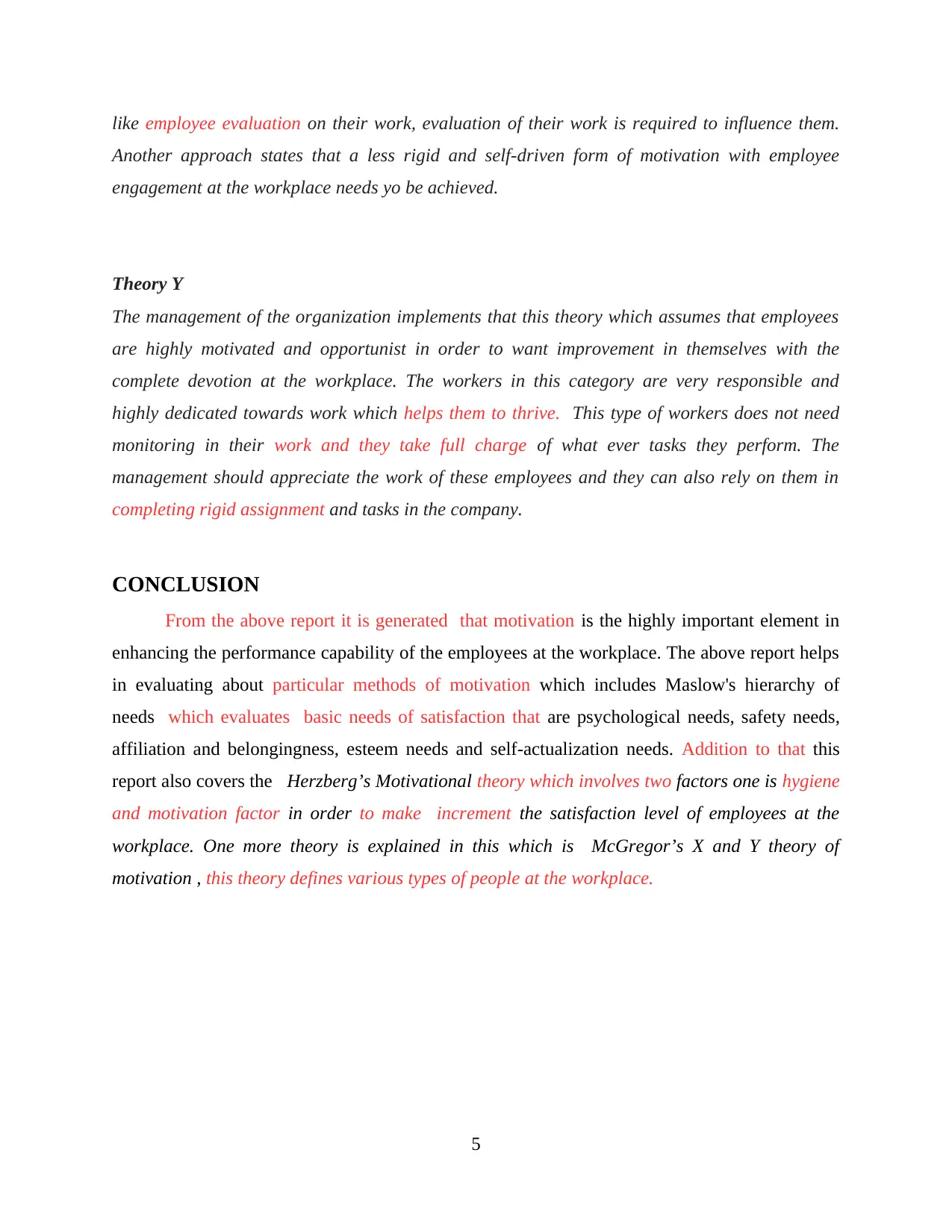
like employee evaluation on their work, evaluation of their work is required to influence them.
Another approach states that a less rigid and self-driven form of motivation with employee
engagement at the workplace needs yo be achieved.
Theory Y
The management of the organization implements that this theory which assumes that employees
are highly motivated and opportunist in order to want improvement in themselves with the
complete devotion at the workplace. The workers in this category are very responsible and
highly dedicated towards work which helps them to thrive. This type of workers does not need
monitoring in their work and they take full charge of what ever tasks they perform. The
management should appreciate the work of these employees and they can also rely on them in
completing rigid assignment and tasks in the company.
CONCLUSION
From the above report it is generated that motivation is the highly important element in
enhancing the performance capability of the employees at the workplace. The above report helps
in evaluating about particular methods of motivation which includes Maslow's hierarchy of
needs which evaluates basic needs of satisfaction that are psychological needs, safety needs,
affiliation and belongingness, esteem needs and self-actualization needs. Addition to that this
report also covers the Herzberg’s Motivational theory which involves two factors one is hygiene
and motivation factor in order to make increment the satisfaction level of employees at the
workplace. One more theory is explained in this which is McGregor’s X and Y theory of
motivation , this theory defines various types of people at the workplace.
5
Another approach states that a less rigid and self-driven form of motivation with employee
engagement at the workplace needs yo be achieved.
Theory Y
The management of the organization implements that this theory which assumes that employees
are highly motivated and opportunist in order to want improvement in themselves with the
complete devotion at the workplace. The workers in this category are very responsible and
highly dedicated towards work which helps them to thrive. This type of workers does not need
monitoring in their work and they take full charge of what ever tasks they perform. The
management should appreciate the work of these employees and they can also rely on them in
completing rigid assignment and tasks in the company.
CONCLUSION
From the above report it is generated that motivation is the highly important element in
enhancing the performance capability of the employees at the workplace. The above report helps
in evaluating about particular methods of motivation which includes Maslow's hierarchy of
needs which evaluates basic needs of satisfaction that are psychological needs, safety needs,
affiliation and belongingness, esteem needs and self-actualization needs. Addition to that this
report also covers the Herzberg’s Motivational theory which involves two factors one is hygiene
and motivation factor in order to make increment the satisfaction level of employees at the
workplace. One more theory is explained in this which is McGregor’s X and Y theory of
motivation , this theory defines various types of people at the workplace.
5
Paraphrase This Document
Need a fresh take? Get an instant paraphrase of this document with our AI Paraphraser

REFERENCES
Books and Journals
Allen, J., Muñoz, J.C. and de Dios Ortúzar, J., 2019. Understanding public transport satisfaction:
Using Maslow's hierarchy of (transit) needs. Transport policy, 81, pp.75-94.
Berlin-Broner, Y. and Levin, L., 2020. Dental hierarchy of needs’ in the COVID-19 era-or why
treat when it doesn’t hurt. Oral Health Prev Dent, 18(2), p.95.
Bushi, F., 2021. An Overview of Motivation Theories: The Impact of Employee Motivation on
Achieving Organizational Goals. Calitatea, 22(183), pp.8-12.
Foktas, P. and Jucevičienė, P., 2021. Which Motivational Theories Are Suitable to Motivate
Employees Belonging to Generation Y?. In Eurasian Business and Economics Perspectives (pp.
249-264). Springer, Cham.
Himeno, M. and Tano, S., 2019, July. Analysis of Motivation Model Using Real User Data from
Social Games for Smartphones Extended to Social Factors Based on Maslow’s Hierarchy of
Needs. In International Conference on Human-Computer Interaction (pp. 114-124). Springer,
Cham.
Keerthana, Y. and Babu, M.K., 2018. A study on theory x & theory y: implications of teachers in
higher education. International Journal of Management, IT and Engineering, 8(10), pp.222-233.
6
Books and Journals
Allen, J., Muñoz, J.C. and de Dios Ortúzar, J., 2019. Understanding public transport satisfaction:
Using Maslow's hierarchy of (transit) needs. Transport policy, 81, pp.75-94.
Berlin-Broner, Y. and Levin, L., 2020. Dental hierarchy of needs’ in the COVID-19 era-or why
treat when it doesn’t hurt. Oral Health Prev Dent, 18(2), p.95.
Bushi, F., 2021. An Overview of Motivation Theories: The Impact of Employee Motivation on
Achieving Organizational Goals. Calitatea, 22(183), pp.8-12.
Foktas, P. and Jucevičienė, P., 2021. Which Motivational Theories Are Suitable to Motivate
Employees Belonging to Generation Y?. In Eurasian Business and Economics Perspectives (pp.
249-264). Springer, Cham.
Himeno, M. and Tano, S., 2019, July. Analysis of Motivation Model Using Real User Data from
Social Games for Smartphones Extended to Social Factors Based on Maslow’s Hierarchy of
Needs. In International Conference on Human-Computer Interaction (pp. 114-124). Springer,
Cham.
Keerthana, Y. and Babu, M.K., 2018. A study on theory x & theory y: implications of teachers in
higher education. International Journal of Management, IT and Engineering, 8(10), pp.222-233.
6
1 out of 8
Related Documents
Your All-in-One AI-Powered Toolkit for Academic Success.
+13062052269
info@desklib.com
Available 24*7 on WhatsApp / Email
![[object Object]](/_next/static/media/star-bottom.7253800d.svg)
Unlock your academic potential
Copyright © 2020–2025 A2Z Services. All Rights Reserved. Developed and managed by ZUCOL.




